| Number of school districts in town | 10 |
| Number of school buildings in town | 10 |
| Value of school buildings with sites | $6,245 |
| Volumes in library | 87 |
| Value of library | $27 |
| Number of teachers employed | 10 |
| Amount paid in teachers' wages | $1,765.25 |
| Number of children of school age | 398 |
| Average daily attendance | 196 342/1000 |
| Number of weeks taught | 280 2/5 |
| Amount of public money from State | $1,101.20 |
| Amount of money from tax | $617 |
CHURCHES
The Baptist formed the first religious society, about 1827. Their meetings were held at the house of Stephen Sprague, who often conducted the services, and at Reuben Newton's. They were never strong in numbers, and soon after disbanded.THE METHODIST EPISCOPAL CHURCH OF MANSFIELD
Who edifice is situated one mile west of Union Corners, was organized with 10 members, in 1833, by Rev. Mr. Bronson, their first pastor, a circuit preacher. The first meeting was held at the house of Daniel Smith, and among the first members were Bradley Stone and his wife, William H. Robinson and his wife, a Mr. Buell, and Widow Reed. They were connected with the Otto charge, and at one time were quite prosperous, having a membership of about 35. They are now disbanded, - no society, no pastor. The church edifice was erected in 1852, at a cost of $1500, and has sitting for 300 people.THE EDDYVILLE UNIVERSALIST CHURCH
Was organized as the Mansfield and Otto Universalist Society, by Rev. Gideon S. Gowdy, in 1850, and their house of worship, which is a frame structure, and will seat 400 persons, was erected in 1852, at a cost of $1000. The first members were William H. Eddy and wife, Levi B. Eddy, E. C. Eddy and wife, Peter M. Stonebreaker, Clark Smith, L. H. Smith, Stephen Smith and wife, Oakley Swarthout and wife, Moses Bowen and wife, George W. G. Bowen and wife, Wooster Benton and wife, Reuben Walker and wife, Darius Warner and wife, Zenas Butterfield and wife, J. M. Wilson, and G. H. Wilson, of Mansfield; and Selleck St .John and wife, David St. John and wife, F. Skeels and wife, George Skeels and wife, Truman Skeels and wife, Livingston Cross and wife, C. F. Nye and wife, Joel Walkup, and Jacob Galloway, of Otto. The society was reorganized in 1873, by the Rev. O. B. Clark, as the Eddyville Universalist Society, and has a present membership of 30. No pastor.INTERNAL IMPROVEMENTS
The first highway laid out and improved in the town of Mansfield was surveyed by R. Burlingame, Dec. 3, 1823, and described as follows:"Beginning at the town line on the east bounds of lot 4, and extending, in a general northwesterly course, six miles, to the north bounds of the town, tow chains west of the northwest corner of lot 48."
The Erie Railway cuts across the extreme southwest corner of the town. It was completed in 1851, and has no station in this township.
BIOGRAPHICAL SKETCHES
LIVERIUS MCKAY
Was born in Smithfield, Madison Co., NY, June 7, 1809, being the oldest of a family of ten sons of Silas and Sally McKay. Of these children, one died in infancy; four are living at the present time in this county: Sylvester and George E., in the town of Mansfield; Cyrus J., in Allegany; Hiram V. R.,, in Little Valley; while the others are residents of the West, - John J. being located in Minnesota, Daniel B. in Kansas, Napoleon B. in Wisconsin, and Thomas H. in Iowa. His father, Silas, died in Mansfield, in the year 1843; his mother in Kansas, in 1874, at the ages of sixty and eighty-four years respectively.In the fall of 1824 he came with his father, who that year purchased a farm in Mansfield, and settled thereon in the following spring, then removing his family thither from Madison County. He remained upon his father's farm until he was become of age, when he purchased a tract of eighty-six acres of wild land, which is a portion of his present farm, the original purchase having been increased to two hundred acres, but reduced by subsequent sales to one hundred and fifty-seven acres. He has also made large divisions of property to his children.
April 24, 1832, he married Huldah, daughter of Roswell and Huldah Ball, of Mansfield, she being a native of the State of Vermont. She passed from earth, Jan. 14, 1838. One child, the result of this union, is also deceased. He was again married, June 28, 1938, to Susan, daughter of John and Olive Johnston, early settlers of the town of Ashford in this county. She was born at Avon, Livingston Co., NY, Dec. 27, 1815. The issue of this marriage was six children, of who we give the following record: Levi, born May 1, 1839, is a farmer, and resided in Humphrey, this county; Olive M., born August 5, 1840, married Seward Harvey, of Mansfield, and since deceased; Martha, born Jan. 7, 1843, married Lysander Harman, of Randolph and died June 28, 1874; Hanford Silas, born Sept. 28, 1843; died June 14, 1854; Eugene Aram, born July 28, 1845, died Jan. 8, 1874; and Louisa Cordelia, born April 25, 1848, is the wife of Le Roy Fargo, and resides with her aged parents.
A view of the homestead of this venerable couple, surviving pioneer residents of the town of Mansfield, may be seen in this work, together with their portraits.
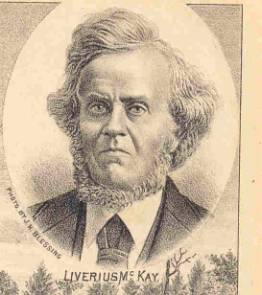 |
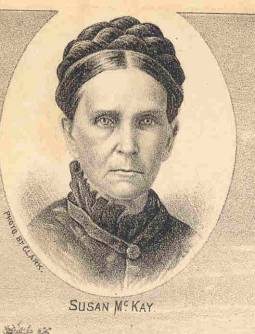 |
| LIVERIUS McKAY | SUSAN McKAY |
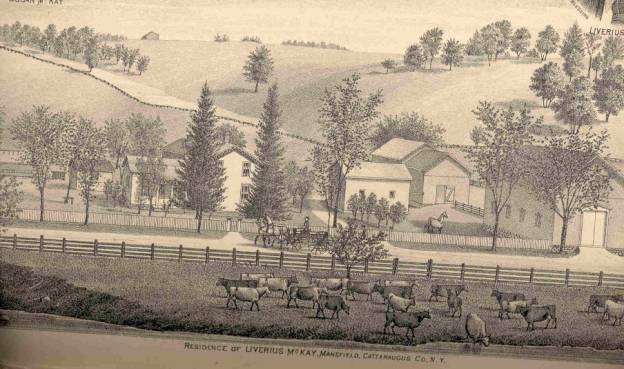 |
| Residence of Liverius McKay of Mansfield |
SAMUEL HARVEY
One of the early settlers of the town of Mansfield, was born in Marcullus, Onondaga Co., NY, March 28, 1801, he being the fourth child and second son in a family of twelve children of Medad and Anar (Buell) Harvey. His parents were natives of New England. His father being a farmer, Samuel spent his early days upon his father's farm, engaged in agricultural pursuits, until the year 1823, when he emigrated to the town of Mansfield, Cattaraugus Co., and settled on the farm where he now resides. His first location consisted of three hundred acres, which he has since, by years of labor and economy, increased to eleven hundred acres, situated in this and adjoining towns. Jan. 28, 1824, he married Mary, daughter of Jonathan and Rhody Reed. Her parents were natives of Massachusetts, and settled in an early day in Carcellus, NY, where their daughter was born, April 13, 1802. They have had four children, one of whom died in early childhood. Mary J. was born Dec. 11, 1828, and is the wife of Warren D. Allen, of Chicago, a noted florist. Albert R., born Nov. 16, 1831, is married and resided with parents. Samuel Austin, born Aug. 9, 1837, is married and lives upon one of his father's farms, located in the town of Little Valley.Mr. Harvey is a member of no church; has always been a Democrat, having cast his first vote for Andrew Jackson. He has been a justice of the peace four years, and supervisor of the town of Mansfield for eight years. But what more especially entitles him to notice is this connection is the fact of his being one of that noble army of pioneers, who, facing westward, in advance of the march of civilization, not only carved for himself a home, but helped lay the foundations of society in all its varied interests. At the advanced ages of seventh-seven and seven-six respectively, he and his wife are serenely passing down the "River of Time."
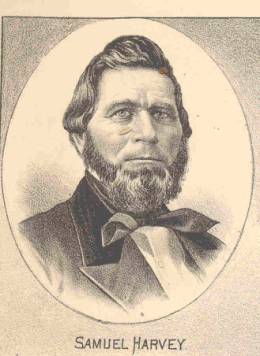 |
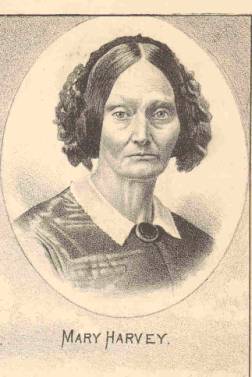 |
| Samuel Harvey | Mary Harvey |
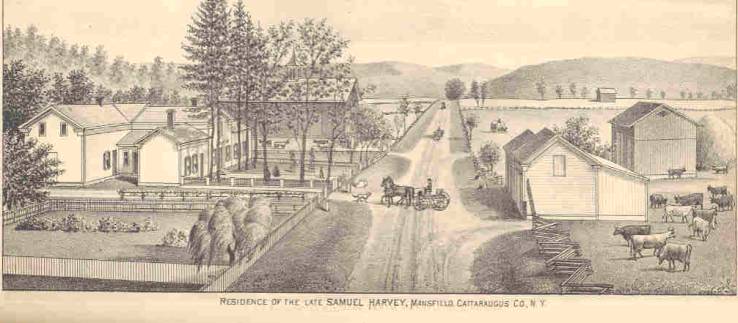 |
| Residence of the Late Samuel Harvey of Mansfield |
LYMAN NEWTON
Whose lives are more worthy to be recorded on the pages of history than they who came into a country when it was in a wild state, and by manifold exertions overcame every obstacle of success and finally were triumphant at the end? Of this class the person of whom we write is a living example. He was born in the town of Truxton, Cortland Co., NY, June 11, 1807, being the second son and third child of eight children of Reuben and Eunice (Manly) Newton. His parents were natives of the State of Vermont, his father being born June 17, 1774; his mother July 15, 1782. They removed in an early day to Cortland County, and when our subject was about a year old emigrated to Maracellus, Onondaga Co., NY. He was a resident of that county a number of years; but finally, in 1823, he located in the town of Mansfield, Cattaraugus Co., and settled and commenced clearing a farm of one hundred acres, in which he was assisted by his son Lyman. The farm is still in possession of the last named. (His parents are both buried in the town; they lived to be over sixty years of age, his father passing away from earth April 21, 1833, and was followed, Aug. 20, 1846, by his worthy partner in life) Lyman lived upon his father's farm till the year 1828, when he started in the world for himself by hiring out to work by the month, in which occupation he was engaged for the space of two years. He married, July 14, 1830, to Sarah D., daughter of Robert and Bethiah Kidney, they being among the early settlers of Mansfield, having removed from Marcellus, Onondaga Co., in 1824. Their daughter was born in the latter town, Dec. 27, 1811.In the fall after his marriage Mr. Newton purchased his first farm, consisting of one hundred acres of wild land, and commenced to clear it; he has followed the business of farming ever since, and at one time kept the largest dairy in the county, milking eighty-five cows. He has increased his worldly possessions by industry, economy, and frugality, so that he is now the owner of eight hundred acres of land, all located in a body in the town of Mansfield.
The fruit of his marriage was two sons, - Milton, born Sept 27, 1834, and Myron L., born June 15, 1836, - both of who are married, and reside on farms adjoining their father. Politically, Mr. Newton formerly belonged to the old Whig party, but joined the Republican on its organization, and through solicited a number of times to hold public offices has always steadily refused to serve his fellow-citizens in that capacity. Himself and wife were originally members of the First Baptist Church of Mansfield; they still believe in that form of Christian religion; but that church having become extinct they have never connected themselves with any other. The first religious services ever held in the town of Mansfield were at his father's house.
Mr. Newton, now at an advanced age, looks back upon a life spent with a great deal of pleasure. He, in connection with his worthy helpmate, with no other legacy than their hands, have amassed a fortune of which they may be justly proud; they have worked hard, but success has attended their efforts, and we only hope they may be permitted to enjoy for a number of years the fruits of their industry.
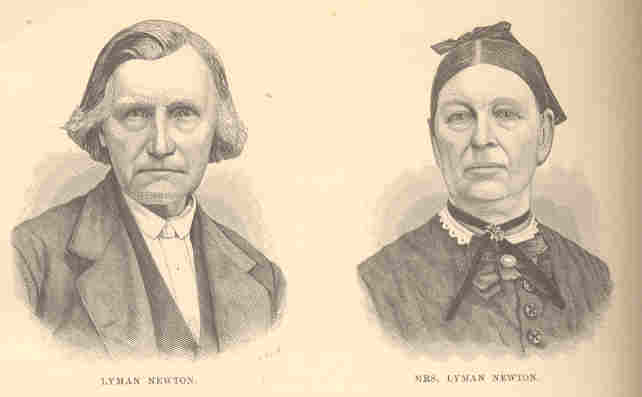 |
| Mr. and Mrs. Lyman Newton of Mansfield |
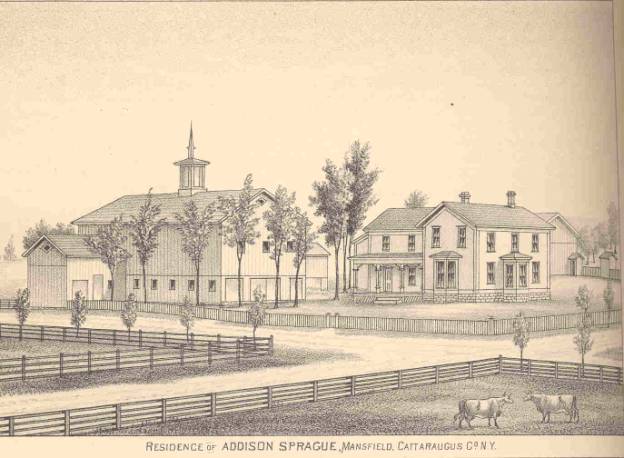 |
| Residence of Addison Sprague of Mansfield |
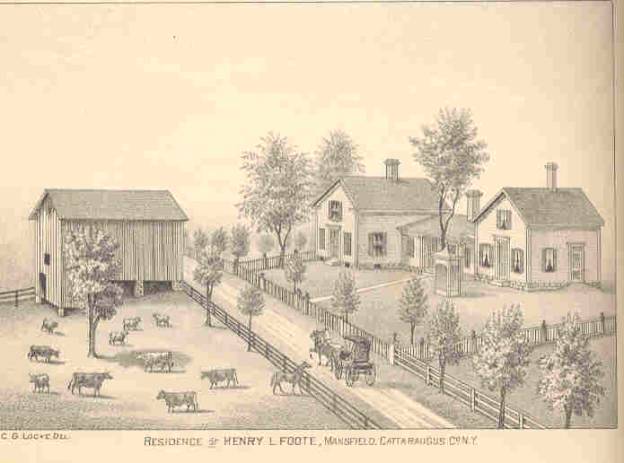 |
| Residence of Henry L. Foote of Mansfield |